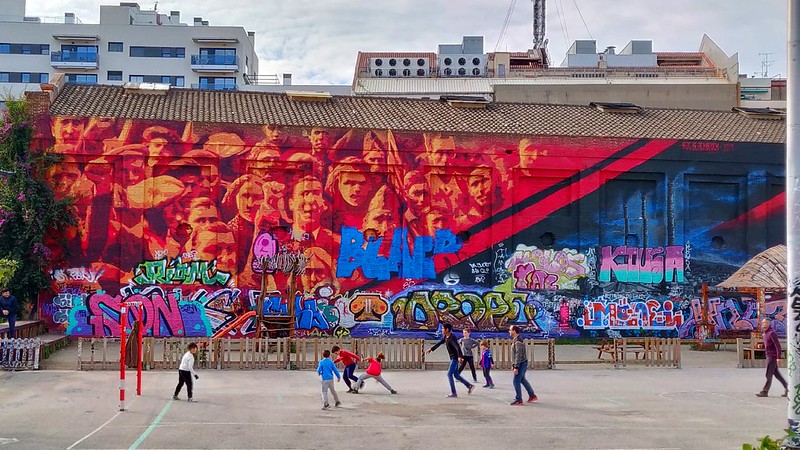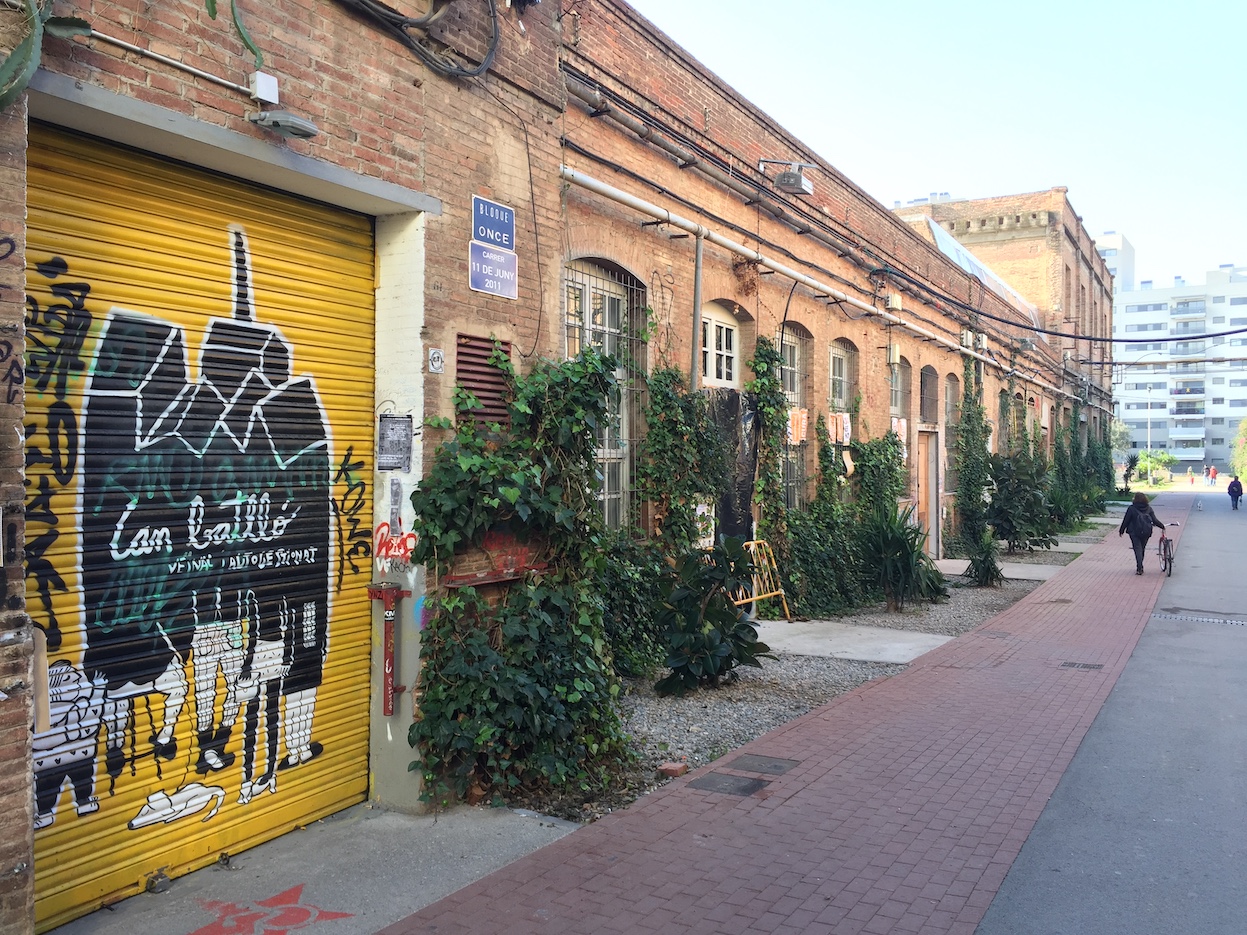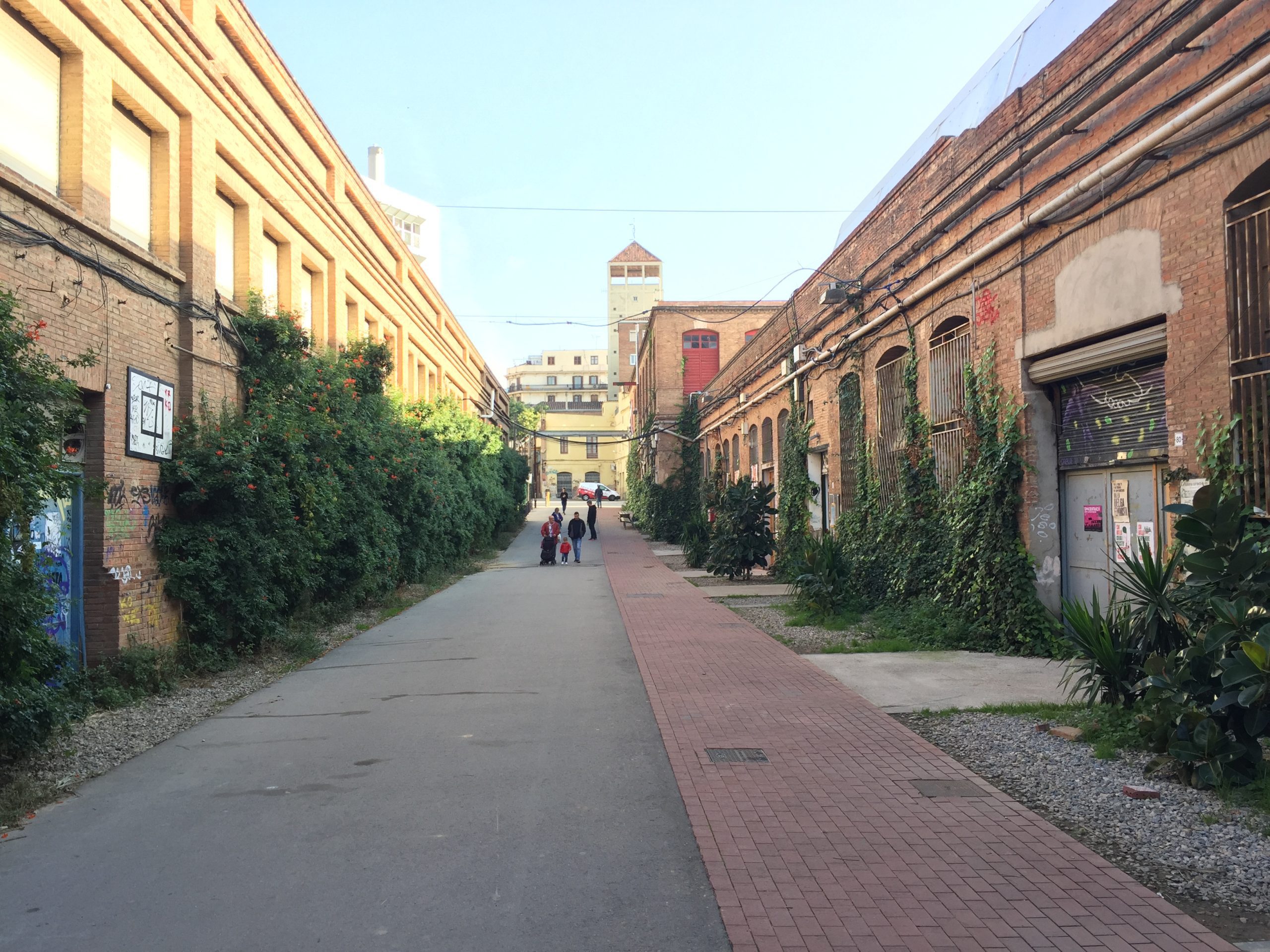Like other major European cities, Barcelona has a great industrial heritage that can now be re-used for a new and different development of its urban life, regenerating spaces, places and communities. The former Can Batlló factory, a post-industrial infrastructure in La Bordeta neighbourhood of the Sants district, is part of this industrial heritage. Due to its size of 14 hectares, the general interest and dynamics, Can Battló became a site of experimenting with new ways of conceiving and regulating the urban commons. This story is also of significant interest for other cities engaged in bringing urban planning closer to the social activism of its citizens.
The story of “an invisible giant”
Founded as a textile factory in 1880 with the name “Sobrinos de Juan Batlló”, the structure was one of the key economic drivers of Sants’ transformations at the end of the 19th century. In 1976 the Metropolitan General Plan (PGM) defined Can Batlló’s site as “an area of public facilities and green spaces”. This decision triggered a long fight by the industrial owners of Can Batlló – the real estate corporation “Desarrollos Inmobiliarios Grupo Gaudir, SL” – that since the end of the 1990s, in a period of massive building speculation, has negotiated several planning changes to obtain greater benefit from the site, in particular from a new project: the construction of several luxury tower houses exploiting the strategic location on the Gran Via, one of Barcelona’s main streets.
With the arrival of the real estate crisis in Spain in 2008, the investor’s interest has stopped. The lack of recovery for such a long period of time, however, had effects on the neighbourhood: since 1976, La Bordeta has been lacking public facilities that were supposed to be built in the Can Batlló site. The district’s indignation led to the constitution of the Platform “Can Batlló es pel Barri” (“Can Batlló is for the neighbourhood”), a group of citizens who have always followed the state of (non)progress of the works. Faced with the immobility of the municipality not complying with any of the project’s deadlines, the Platform decided to give an ultimatum: if by 11 June 2011, works were not starting in Can Batlló, the Platform would enter and start building the structures they need themselves. Thus began a countdown, a media campaign aimed at strengthening and legitimising the Platform with the support of various associations and social movements of Sants and the whole city.
Shortly before the date of entry defined by the citizens, the municipality had started to negotiate with the owners for the acquisition of the site in order to protect the citizens, as well: as the municipality took the property of the Can Batlló site, citizens were occupying a public asset and the municipality coulc decide to negotiate with them, in this way an eviction from a private property was avoided. The first space occupied and reassigned is called “bloc onze” (in memory of the historical date of entry in Can Batlló by the Platform) and marks the beginning of a new phase in the process of rehabilitation and transformation of Can Batlló. Since then, the Platform has been active as a space for reflection and claim for the neighbourhood’s surroundings, collectively rethinking its urban transformation. With the subsequent acquisition of the building, the municipality supported the occupation by giving legitimacy to the occupants and returning the space to the neighbourhood with a concession that gives responsibility to the public administration responsibility to maintain the building’s external structure while the management of the activities inside Can Batlló are responsibility of the neighbourhood association, Platform “Can Batlló es pel Barri”.
An enabling system
Since 2011, the inhabitants of La Bordeta involved in the regeneration of Can Batlló have decided to organise all their activities with a horizontal, inclusive and transparent monthly assembly composed of working committees. The assembly decides about all the activities, uses and plans for the sustainability of the space. Inside Can Batlló, almost four hundred citizens have been working cooperatively and voluntarily to meet the social needs of the neighbourhood, rehabilitating the spaces collectively, refurbishing and making the space available to everyone without any distinctions.

The General Assembly is held on the last Wednesday of each month and is the place where main decisions are taken. All committees and projects are involved and invited to participate, committees are more organizational structures while projects are more singular activities. The commissions and projects are divided into 4 major groups:
- internal structure – made of the following committees: Secretariat and Reception for the Neighbourhood and Visitors Dissemination, Strategy, Negotiation, Economy, Space Design; Infrastructures
- arts and crafts – the Arts Can Batlló committee plus the following projects: Carpentry, Collective Printing, Mobility, Audiovisual Laboratory of Can Batlló AvLabCB, Espai Eines (School of Trades), Beer Workshop, Sewing Workshop
- education and documentation – composed by the following projects: Josep Pons Popular Library, La Fondona, Social Movements Documentation Center, Arcadia School
- culture and leisure – the Activities committee plus the following projects: Meeting space, Bar, La Nau, Children’s and family space, Community Orchards and Gardens, Musical Creation Space, Climbing wall, Performing arts and circus training space, La Garrofera de Sants, La Borda, Coopolis
Open meetings are often held on specific topics such as economics, space improvements, and discussions on the urban transformation of the entire site. The General Assembly has also discussed, planned, and followed for more than two years the renovation of the “bloc onze”, the first building financed by the municipality, through collective work sessions.
The first space to be set up was the Josep Pons’ popular library. Later, a bar and meeting space, an auditorium, a climbing gym and several multifunctional rooms for activities and workshops were renovated. As the working group and the interest grew, the Platform also managed to recover more spaces within the same complex for other community projects and always in the same way: the municipality took the property of the spaces one-by-one and then assigned the management to the Platform. Over the years, other locations have been transformed and new uses have been identified: a repair shop, a carpentry shop, a collective printing shop, a documentation centre, a space for families, a space for the arts, and a circus arts gym. In 2013, together with the new street “Carrer de l’Onze de Juny de 2011″, opened to stretch across the site from one end to the other, the first community garden (50m2) was inaugurated.
The Platform “Can Batlló es pel Barri” has worked and questioned the precedent urban planning project for the area and worked on new proposals that revise the transformation of Can Batlló. Since its activation, the Platform has made adjustments and improvements to the Metropolitan General Plan of Can Batlló-Magòria.
Self-management, collaboration in general activities, maintenance and good functioning of the project are the essential commitments for all people and groups joining the “bloc onze”. The Assembly decides on the self-financing methods that are allowed internally according to the following guiding criteria: projects or individuals who contribute with money cannot run activities that are against the principles of the “bloc onze” and cannot endanger its independence. Can Batlló is engaged to move towards economic self-sufficiency at all levels of the organisation, within the commissions, working groups and the General Assembly. It is everyone’s commitment to work towards this goal creating processes of independence from grant funding and/or public funds. People and groups using the spaces for activities must contribute to the community with a social and/or economic return. The path towards economic self-sufficiency does not derive from a position against the municipality but from an entrepreneurial vocation embedded in the history of the place. Multifunctionality, activism and periodic change of activities make this place a new generator of economic and social life in the Sants district.

A new legal and conceptual framework
The internal organisation and social activism of its inhabitants have made Can Batlló an enabling system. In this process, a non-secondary role has been played by the municipal administration, which has been able to adopt new tools for the co-management of urban commons. These new tools are the result of a significant paradigm shift in the ways of conceiving the public sector.
In 2016, the city council led by Barcelona en Comù (a political party including several social activists aiming to bring citizens closer to political life in an active way) started a work to define the rules of co-management of publicly owned spaces together with the Network of Community Spaces of Barcelona, the XEC – Xarxa d’Espais Comunitaris. The Network has long been asking for parameters that could go beyond the dominant market logic and to redefine ways to measure activities within the co-managed spaces. In this way, a work towards a new conceptual and normative framework based on a definition of urban commons started. A systemic vision of city facilities has also been adopted, a vision in which libraries can also host social services, opening up to other needs of the surrounding area. The municipality was also beginning to have a new position and a new language: goods and services once in the hands of the “public” can now be managed as “commons”. The city council wanted to promote processes such as Can Batlló where local communities are able to organize and have a positive social impact working for a common good. As a result, this change led to the definition of the “Programa de patrimoni ciutadà d’ús i gestió comunitàries”, the Citizens Assets Programme.
Within this new programme, the concession of more than 13,000 square metres to the Can Batlló neighbours’ association represents another important innovation: a politically risky decision, a process of innovation within the local administration that has pushed technicians to go beyond the comfort zone of their usual office work. For the first time, an urban planning concession has been given in the favour of a self-managed non-profit entity considering that the community project of Can Batlló constitutes an important social benefit for the city of Barcelona, measured and monitored according to new administrative tools: the community balance and social return.
Social Return
An urban planning concession such as the one allocated to Can Batlló is normally granted to private and large construction companies because a municipality must always “justify” the concession with an immediate monetary return or a future real estate return: in that case, the building at the end of the concession returns to the hands of the municipality. On the contrary, the Can Batlló Neighbours’ Association wanted to obtain the management of the space through an urban planning concession within the new Citizens Assets Programme because this type of agreement could guarantee them more freedom inside the site. The concession obtained for a period of 30 years, expandable to 10 or 20 more years, allows the association to plan the activities with a great stability and to better plan for the common good.

The initial media interest aroused and the work carried out over the years by the Platform led the neighbours of Can Batlló to a productive dialogue with the administration, succeeding in involving several working groups and municipal technicians (particularly in the areas of heritage and participation). The challenge, once the political will was found, was to try to “hack” the system that regulated concessions and find a way to justify the concession even without an immediate monetary return.
The valorisation of the work done by all the volunteers of the Platform over the years within Can Batlló was the expedient to justify the concession. The social return generated by Can Batlló does not have a monetary value in itself but trying to “translate” into economic terms the time spent by the volunteers of Can Batlló – in recovering the whole structure and offering the services that would be otherwise offered by a civic centre of the municipality – was the only way to be engage the municipality and obtain the concession.
In order to measure economically the work done by the community, two evaluation methods have been adopted for a more objective comparison. The first method involves the monetary valuation of the unpaid work hours of volunteers and activists. The second method involves the monetary valuation of the cost that the administration would have to sustain if it decides to take over the activities and services currently active in Can Batlló. In this way, it is possible to measure how much the city of Barcelona benefitted from the self-managed social activism of Can Batlló neighbours in a monetary way.
Taking into account the total number of hours worked by the volunteers between 2012 and 2017, it is possible to make an overall assessment of the historical cost of Can Batlló. Counting the hours of volunteering since the beginning of the regeneration process of Can Batlló, including the hours dedicated to space development (construction), community management (assemblies and participation spaces), group activities (projects and commissions), cleaning its premises, festival spaces and maintaining the spaces, the community project would have costed €3,959,500 in salaries between 2012 and 2017.
With these numbers, the Municipality of Barcelona justifies the investment already made in Can Batlló, recovering the building and giving legitimacy to the neighbours association. The calculation of the Social Return is thus able to “hack” the urban planning concession. These numbers linked to the funding received by the municipality make it possible to measure the return on public investment, which is approximately €4 for every euro spent.

A special public-community relationship
Can Batlló’s experience demonstrates the importance of both community networks, which act as intermediary bodies, and the involvement of technicians and citizens to innovate in local government. A new regulatory framework and new tools for measuring and accompanying projects oriented towards the common good are the result of a (not easy) collaboration between two worlds, that of activists and that of technical administrators, who often find themselves in a conflictual relationship. However, the case of Can Batlló does not exhaust and does not resolve the tensions that will continue to exist, both among activists and technicians, even within a government that fully supports the cause of the common good. The challenge now is to demonstrate that the regeneration of Can Batlló is a bet won by all, especially by those who have devoted the most time to its development.
A final result will be defined above all by a correct definition and use of tools such as community balance and the social return. It is necessary to prevent community balance from becoming one of the many ways in which the local government can control community projects. In order to succeed in this, there must be a recognition of the political relevance of these tools, claiming their use, and claiming also for a different role of the municipality that must act as a continuous facilitator, promoting these community processes, not forgetting that there are no commons without commoning, and therefore without community. The effort made so far reveals the city of Barcelona’s commitment to change the way it conceives “the public sphere” also for future governments, creating internal tensions within the administration. It is also worth mentioning the effort made by Can Batlló’s neighbours in forming an association to facilitate communication with the public administration. Community, co-design and communication have been the key elements in making Can Batlló a good reference project in the field of urban regeneration studies.
Written by Jorge Mosquera.
This article appears in the book The Power of Civic Ecosystems: How community spaces and their networks make our cities more cooperative, fair and resilient.

